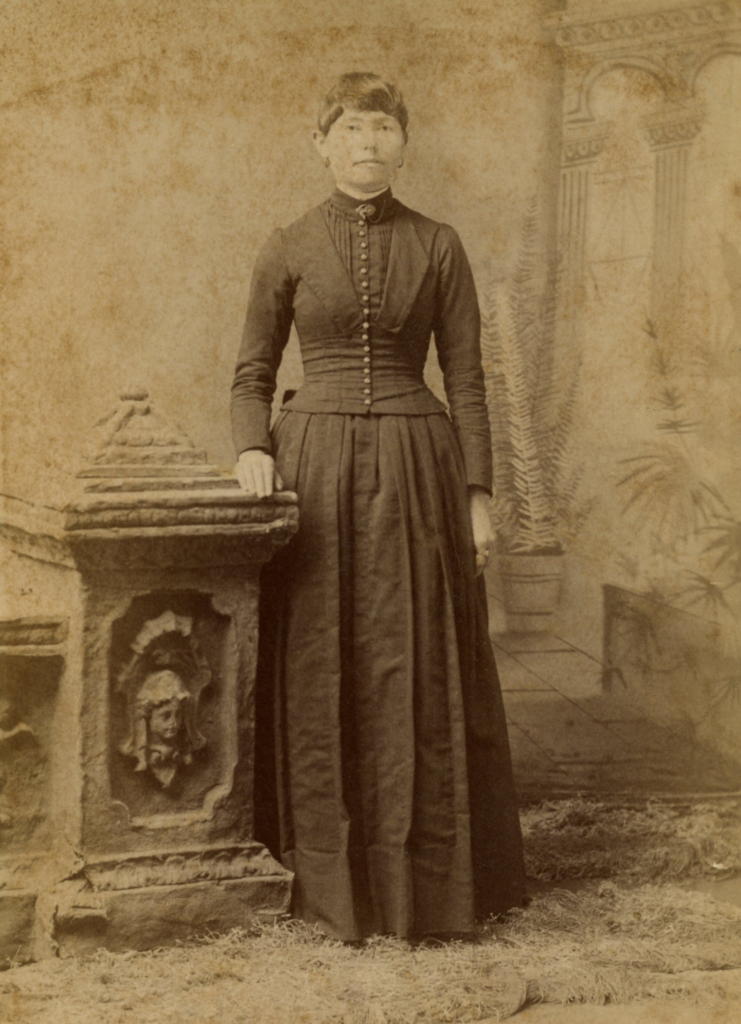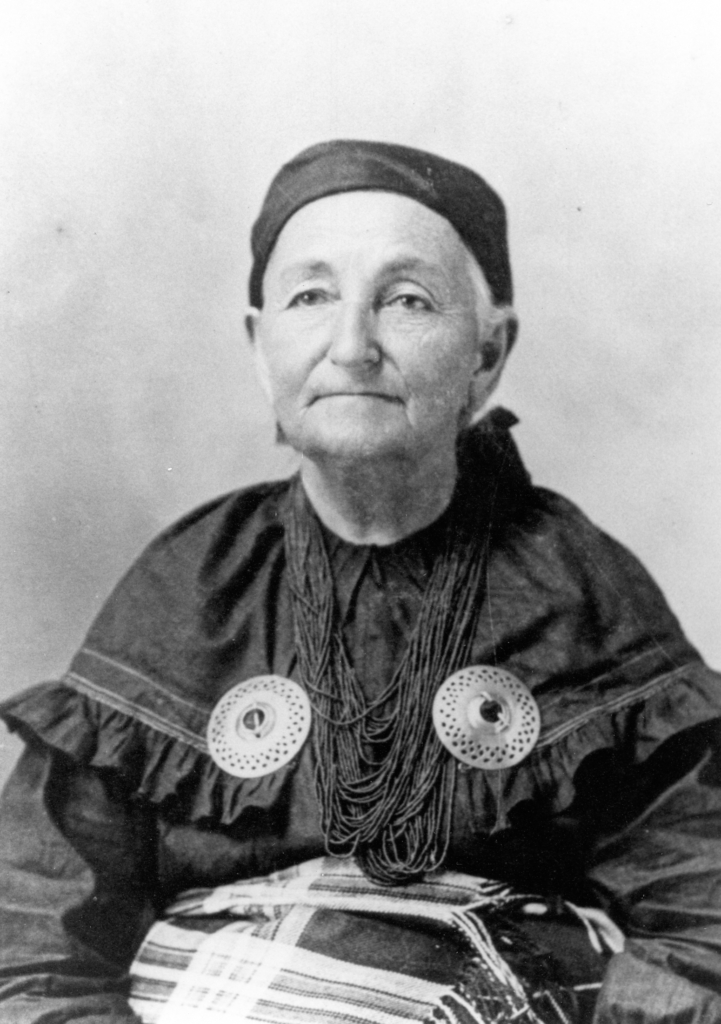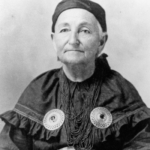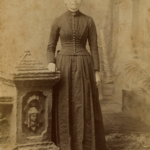By Anderson family descendant Tommy Craig Bokegway Anderson
The Evening Gazette, Oklahoma City, Oklahoma Territory — Saturday, Dec. 27, 1890
Hot Winchesters
John Bly Shoots and Instantly Kills Pete Anderson
Just Over the Pott Line
A Fierce Fight Results in Bly’s Capture
Yesterday afternoon while the chimes of a merry Christmas were still ringing in the ears of the children of this world another bloody crime was recorded on Oklahoma’s sanguinary calendar. Another man was killed and today seven little children in his home mourn for him and refuse to be comforted. The county jail contains another prisoner and the taxpayers of the county will be at the expense of his trial the result of which no living man can foretell.
In 1871, Peter “Pete” Anderson (age 27) and his wife, Julia Hardin (age 16) came to the “Pott Country” with the first group of Citizen Band Potawatomi families to relocate from Kansas. Pete Anderson was born in Illinois in about 1845 and was the third child of John Anderson and Marie Trombla and younger brother of John Anderson and Mary Anderson Bourbonnais.
Pete had been to the heart of Indian Territory before. In 1868, Pete, Joe Melot and James Baldwin had attempted to scout the area as a possible new reservation for the Potawatomi. However, after facing impassible wagon roads, deep mud and overflowing streams, they had been forced to turn back. A second attempt met with greater success in the winter of 1869. After several days of cold and hard travel, the group successfully arrived and selected a 30-mile-square tract of land lying between the North and South Canadian rivers. This became the new site of the Citizen Band reservation.
Just prior to the relocation to the new reservation lands, Pete and Julia were married in Shawnee County, Kansas. Julia, also Potawatomi, was the daughter of John Hardin and Margaret LaFromboise, and was born in Council Bluffs, Iowa, in about 1854. Julia was the younger sister of Elizabeth Hardin, who was married to Pete’s brother, John.
Pete and Julia began a family at their first home in Oklahoma about 18 miles northeast of Purcell, near present-day Wanette. The children born there were William, Isabelle, George, Nellie, Davis, Frank and Benjamin.
Julia died at the birth of Benjamin in about 1886, and by 1889, Pete and the children had left the southern part of the reservation and selected allotments in the far northwest corner of the reservation near present-day Choctaw. However, because of the location of the new home, Pete found himself involved in controversy relating to events surrounding the Monday, April 22, 1889, land run that opened the unassigned lands just to the west of Potawatomi lands.

Pete Anderson’s place, called the Lazy A, was about four miles southeast of the famous 7C Ranch, owned by William J. McClure (age 46). Because of the strategic location of the 7C Ranch on the Shawneetown road, a crowd estimated to be near 1,000 people with 360 wagons gathered along the “Pott Line” in anticipation of the noon opening. Among the crowd that day was McClure’s nephew, Frank M. Gault (31), C.F. Johnson (24) and John Reed (29), who was married to Pete’s sister-in-law, Mary Louise Hardin.
This group established a campsite near Pete’s place several days before the opening. On Saturday before the opening, Gault and Reed visited the Anderson home and probably discussed their strategy for the approaching land run with Pete and two other guests already there, John Clinton, second husband of Margaret LaFromboise Hardin, and William McMurray (58) livery, who lived near Dave Hardin and Antoine Bourbonnais.
The distance from the eastern boundary of Oklahoma Territory to the Oklahoma Station, the first Santa Fe depot before the land opening, was about 14 miles. Gault claimed he made the ride in one hour and 10 minutes and was the first to stake his claim in Oklahoma City.
Gault stated, “The horse I rode had been trained for its purpose, had been a racehorse; he was 15 and a half hands high, dark bay, black mane and tail and weighed about 1,000 pounds.”
Immediately, protests arose as witnesses declared that Gault and McClure had been inside Oklahoma Territory prior to the opening and had stationed cowboys with relay ponies for the purpose of making the run to Oklahoma Station. Among the witnesses who claimed to have seen Gault’s cowboys were John Clinton, William Daniels, son-in-law of John Anderson, and Joe Whipple, Potawatomi freighter for Mr. Scott of Shawneetown.
Another witness who claimed to have seen the cowboys was the notorious John Bly, who was inside Oklahoma near Crutcho and Soldier Creeks at noon on the day of the run. Bly, described as “powerfully built … with a clear, cold deliberate eye” was a long-time resident of the Chickasaw Nation. More recently, Bly had lived a few miles east of Choctaw City and had acted as constable there for some time.
Despite the witnesses, Gault’s claim was eventually upheld. However, John Bly continued to be a thorn in the side of Gault, McClure and other cattlemen in the area. Bly was the son-in-law of Choctaw Justice of the Peace Barnett and had a reputation as a crack shot. He also had a reputation for highway robbery, horse stealing and many other crimes in the Chickasaw Nation for which he had been arrested several times but never convicted.
John Bly, born 1869 in Missouri, was the second son of James and Kizziah Bly. In the spring of 1885, James Bly was postmaster of the Bly post office in Clarke County, Kansas, but by 1887, the Bly family had settled near Purcell, Oklahoma. At that time, the family also included Givens (born 1867) and Clyde (born 1877). By 1890, Givens had married Mary Elizabeth West, and both were working at the 7C Ranch.
John Bly and his gang, which included James Bly, Givens Bly and possibly James D. Barnett, Richard Burchfield and Charles Wilson, had been harassing cattle men and settlers in and around Oklahoma City for several years prior to 1890. Law enforcement had been unsuccessful in convicting the Bly gang for several years.
In addition to the cattle stealing going on around Choctaw City and the 7C Ranch, the illegal sale of whiskey was a source of concern and irritation to the local Indian Agents and the Commission of Indian Affairs. An October 23, 1890, report by the Sac and Fox Agent to the commissioner identified several saloons in Choctaw City illegally selling whiskey. Saloon men named in the report included John Bly.
On Christmas Day, 1890, District Judge John G. Clark of Oklahoma City issued bench warrants for Bly’s arrest on charges of stealing cattle and selling whiskey. Clark specially commissioned Gault, giving him authority to swear in his own deputies. Sheriff DeFord deputized Gault and Pleas Gilbert on Christmas night, and by the next morning, they had arrived at the scene a few miles east of Choctaw.
Temperatures dipped into the low 30s on the morning of December 26 as Gault and Gilbert enlisted the aid of Pete Anderson and Frank Cook, “two citizens of the Pott Nation.” According to newspaper accounts of the story:
The party started for the Shin Oak neighborhood and had not ridden far before shooting was heard in advance of them. The officers dismounted and proceeded afoot in the direction of the shots. Across a ravine and in front of them a man was discovered standing with a Winchester in his hand as if doing picket duty. The Gault party crossed the ravine and made directly for the fellow who commanded them to go back at the same time dropping down amid the scrub oaks. He opened fire, and the first bullet struck Pete Anderson square between the eyes, killing him instantly. Gault and Cook went down behind the bushes and welted away at the fellow who had precipitated the battle. Something like a dozen shots were fired by each of the party, and things became mighty warm around there for a time. Finally, the man’s gun went up as a flag of truce, and he called out to Gault that he had been shot. The officer had him throw away his gun and march up under cover of a red-hot Winchester. It was John Bly, the man wanted, and Mr. Gault very artistically proceeded to gather him in.

One of Pete Anderson’s daughters, Isabell Anderson Mims, was about 14 years old when the shooting occurred. Almost 50 years later, Isabell remembered that “…old man Bly and son … killed Father from ambush. … He was just 40 years old.” With the Bly gang in custody, Oklahoma Territory newspapers hailed Gault a hero and dubbed him “The Cowboy King of Oklahoma City.”
John Bly, James Bly and Givens Bly were formally arrested at the scene in Pottawatomie County by C.H. DeFord, Deputy U.S. Marshall of Oklahoma Territory. John Bly was covered with blood from his wound to the fleshy part of his shoulder and arrived at the Oklahoma City jail just after dark on the evening of December 26.
William West was a detective on the Bly case, and indictments were prepared and filed. The July 16, 1891, indictment for murder listed the title of cause as Territory of Oklahoma vs. John Bly. An indictment for larceny also filed July 16 reflected Territory of Oklahoma vs. Richard Birchfield, John Bly and Givens Bly.
In 1892, Guthrie, Oklahoma, was home to one of the very first federal prisons in the Midwest. John Bly was eventually transferred to this United States jail and had been there for several months as of December 1892. The murder case against Bly was to be set for April 17, 1893, in Oklahoma City; however, John never made it to trial. An article in the Dec. 31, 1892, edition of the Oklahoma State Capitol newspaper published at Guthrie told the story that apparently brought John Bly’s involvement in the Pete Anderson murder case to an end.
Cheated the Gallows
A Noted Outlaw Dies in the Guthrie Prison
The notorious outlaw, John Bly, wanted for several murders and many highway robberies and horse stealing has escaped beyond the law’s clutches. He died in the United States jail. The authorities of Purcell telegraphed up for the body, and Coroner Reder embalmed and shipped it to them. The outlaw died of consumption.
The other individuals involved in the incident apparently spent some time in prison, but the details are not known. It is known, however, that James Bly, the father, died in Purcell in 1891. Also, in the late 1920s, Victor Gene Anderson remembers as a child a man coming to his home and talking to his father, Davis, about the incident. He was one of the men involved. Davis became angry and told the man to leave and never come back. Givens Bly went on to live a long life and died in 1959 in Dale, Oklahoma.
The Dec. 27, 1890, edition of The Evening Gazette described Pete Anderson as “well known in this city by a great many of the businessmen who speak in the highest terms of him. He was a man of considerable means and well known all over the Pott country.” However, in a 1937 interview, Pete’s daughter Isabelle stated, “Father was not a cattle man, just a farmer, but a good provider.”
I guess that will have to serve as Pete’s epitaph, because we do not know where Pete is buried or if he had a memorial headstone at that location, wherever it may be. There is a cemetery at Choctaw, The Elmwood Cemetery (or Choctaw Cemetery), that is on land once owned by Pete’s friend Frank Cook who was with Pete when he was shot. We thought Pete may have been buried there. A City of Choctaw historical booked identified the Elmwood Cemetery beginning as a boot hill for cowboys of the 7C Ranch. On the other hand, Pete’s wife, Julia, died during the birth of Ben Anderson, and we think she was buried near Wanette, perhaps at the old abandoned Pleasant Prairie Cemetery about a quarter mile east of Julia’s allotment. It could be that Pete was taken down there to be buried near Julia. It has been many years since any tombstones were visible at Pleasant Prairie. Cows graze there now. If anyone out there has any idea of the final resting place of Pete and Julia (Hardin) Anderson, we would like to know it. Migwetch (Thank you).
This year is the 132nd anniversary of Pete Anderson’s death on December 26. He died in gunfire while assisting with the capture and arrest of members of the Bly Gang in 1890. Tommy Craig Bokegway Anderson, a Citizen Potawatomi Nation tribal member and descendant of Pete Anderson, continues to search for the burial sites of Pete and his wife Julia in present-day Oklahoma. Please send any information to hownikan@potawatomi.org.


